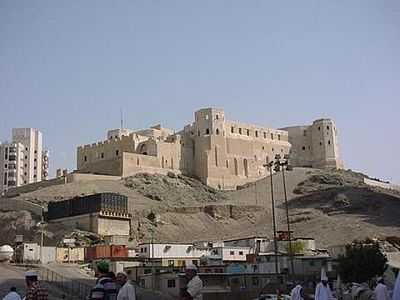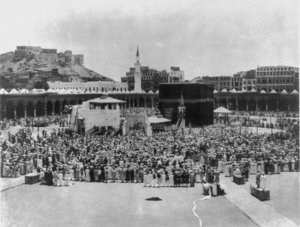Ajyad Fortress

The Ajyad Fortress (Turkish: Ecyad Kalesi; Arabic: قلعة أجياد) was an Ottoman citadel which stood on a hill overlooking the Grand Mosque of Mecca, in what is now Saudi Arabia. Built in the late 18th century, it was destroyed by the Saudi government in 2002 for commercial development of the Mecca Royal Hotel Clock Tower, sparking global outcry.
History
In 1780, the Ottoman Turks built the fortress in order to protect the Kaaba and Islamic shrines in Mecca from bandits and invaders. At the time, many of the bandits and invaders were Wahhabi radicals and the Ottomans wanted to keep them out of the city.[1][2] The fort covered some 23,000 m2 (250,000 sq ft) on Bulbul Mountain[3] (a spur of Jebel Kuda) overlooking the Masjid al-Haram from the south.
In early 2002, the Ajyad Fortress was demolished and most of Bulbul mount was levelled,[4] in order to clear the area for the $533 million construction project[5] of Abraj Al Bait Towers.[6] Opening in 2012, the complex of multiple high-rise buildings consists of apartments, a twin-tower five-star hotel, restaurants, and a shopping centre, built by the Saudi Binladin Group.[7]
Reactions

The destruction of the historic structure stirred both domestic and international protest.[8] The Turkish Foreign Minister İsmail Cem İpekçi and other institutions tried to prevent the demolition.[9] The Turkish Democratic Left Party (DSP) Deputy Ertuğrul Kumcuoğlu even suggested a boycott on travelling to Saudi Arabia.[10] The Turkish Ministry of Culture and Tourism condemned the obliteration of the fortress, comparing the act to the destruction of the Buddhas of Bamyan, and accusing the Saudi authorities of "continuing with their policy of demolishing Ottoman heritages."[11][12]
The French news agency Agence France-Presse (AFP) quoted Saudi Islamic affairs Minister Saleh al-Shaikh as saying "no-one has the right to interfere in what comes under the state's authority". In reference to the housing component of the plan, al-Sheikh added that it was intended to house pilgrims to Mecca, and said "this is in the interest of Muslims all over the world".[5]
However, the destruction of this and other historic sites fueled criticism of the Saudis, and plans were made to rebuild the castle, as ordered by the King in 2001:[4][13]
King Fahd has given his approval for the King Abdul Aziz Endowment for the Holy Haram and for the preparation of the project site by removing the hill and the castle. The king instructed that the castle should be preserved in full by rebuilding it," the minister said in a statement.
A 1/25 scale model of the fortress is included along with other architectural models at the Miniatürk miniature park in Istanbul, Turkey.[14]
See also
- The Qishla of Mecca
References
- ↑ Simon Wheelan (28 January 2002). "Saudi government demolishes historic Ottoman castle - World Socialist Web Site". Retrieved 20 January 2015.
- ↑ "BBC News - MIDDLE EAST - Saudis hit back over Mecca castle". Retrieved 20 January 2015.
- ↑ Article from the Arab News of 9 January 2002
- ↑ 4.0 4.1 Article in the Arab News of 26 December 2001
- ↑ 5.0 5.1 Wheelan, Simon (2002-01-28). "Saudi government demolishes historic Ottoman castle". World Socialist Web Site. Archived from the original on 10 May 2008. Retrieved 2008-04-02.
- ↑ Article from the Brunei Times by Pakinam Amer from Sunday, April 15, 2007, naming the demolished fortress and the new building in the same sentence
- ↑ "Abraj Al Bait: a city within a city". Qatar Construction Sites Newspaper. Retrieved 2008-04-09.
- ↑ Gossett, Sherrie. "Mecca Conference Criticized for Hypocrisy on Holy Site Destruction". crosswalk.com. Archived from the original on 18 May 2008. Retrieved 2008-04-09.
- ↑ Article on People's Daily Online
- ↑ "Ecyad Castle". Retrieved 20 January 2015.
- ↑ Palmer, Jason (2002-01-09). "Destroying Ottoman castle to build hotel is 'cultural massacre'". The Independent. Retrieved 2008-04-09.
- ↑ Turkish Ministry of Culture Announcement Retrieved 03-28-2008
- ↑ "Holy site expansion to preserve historic Ajyad Fort". Royal Embassy of Saudi Arabia at Washington D.C. Website. 2002-01-09. Retrieved 2008-04-09.
- ↑ Description and picture of the model on the Miniatürk website.
Coordinates: 21°25′08″N 39°49′35″E / 21.41889°N 39.82639°E